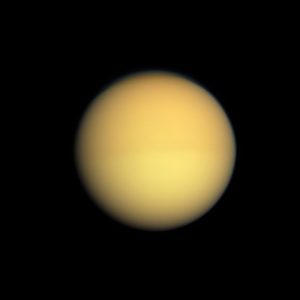
Titan is Saturn‘s largest moon. Its surface is shrouded in a thick cloudy atmosphere of nitrogen (97 percent), methane (2.7 percent), and hydrogen (0.2 percent) along with other trace gases including hydrocarbons such as methane and ethane. This is the densest atmosphere of any moon in our solar system with a surface pressure around 1.5 times that of the Earth‘s atmosphere.
Titan’s surface has permanent lakes of liquid hydrocarbons – the first stable bodies of liquid to have been discovered anywhere other than Earth.
Although Titan’s surface is believed to be too cold to support life, at around -180 degrees centigrade, it is believed that a subsurface ocean could be present with temperatures suitable for microbial life.
Titan has a mean radius of 2574 km – around 1.5 times the radius of our own Moon – and has around 1.8 times the Moon’s mass. When not directly in line with Saturn, Titan can be spotted though a small telescope as a point of light alongside Saturn’s other largest moons, Rhea, Iapetus, Dione and Tethys.
The Cassini-Huygens Mission
NASA’s Huygens probe – part of the Cassini-Huygens mission to Saturn, launched on 15 October 1997 – was deployed from its parent Cassini spacecraft to investigate the atmosphere and surface of Titan on Christmas Day 2004.
Named after the Dutch astronomer Christiaan Huygens, who discovered Titan in 1655, the Huygens probe parachuted through Titan’s atmosphere before landing on its surface. The probe sent back data to the Cassini spacecraft for several minutes after it touched down at 12:43 UTC on 14 January 2005, until contact was lost at 13:37 UTC – a little longer than expected considering the probe’s limited battery life.
This was the first time a probe had landed on a planetary moon, other than our own, and the furthest landing site from Earth of any spacecraft.
Huygens’ 2.5 hour descent phase through Titan’s atmosphere revealed its chemical composition and density as well as its electrical conductivity and radiation levels. Wind speeds of more than 400 km per hour (250 mph) were recorded at an altitude of 200 km (120 miles). At ground level, measurements showed much gentler winds of a few metres per second. Huygens built up a full mosaic image of its landing site, once it became visible below the atmospheric haze, at an altitude of around 25 km (16 miles).
On impact, Huygens made a dent around 12 centimetres deep before bouncing and sliding 30 to 40 cm across the surface. Analysis of the impact suggested a surface made of sand-like grains of ice, or snow that had been frozen on top.
Huygens’ photos of its landing site show an orange surface shrouded in haze, due to the absorption of blue light in Titan’s atmosphere. The surface was scattered with pebbles likely to be composed of water ice covered in a layer of hydrocarbons. Huygen’s landing site is believed to be a dry lake bed, as the photos suggest evidence of recent liquid erosion on the surface.
Huygens measured the temperature at its landing site as 93.8 Kelvin (−179.3 degrees Celsius or −290.8 degrees Fahrenheit) and the atmospheric pressure as 1.4 atm, where 1 atm (or atmosphere) is equivalent to the average air pressure at sea level on Earth at a temperature of 15 degrees Celsius or 59 degrees Fahrenheit.
From the data provided by the Huygens probe, it is believed that rainfall is rare on Titan’s surface, but torrential downpours causing flash floods can occur after decades or even centuries of drought.
From radar observations made by Huygens’ parent spacecraft, Cassini, it was confirmed that permanent lakes of liquid hydrocarbons, such as methane and ethane, exist on Titan’s surface near to its polar regions. This had been predicted previously from observations made of Titan’s surface from Earth-based infra-red telescopes, which had allowed astronomers to see through Titan’s thick layer of cloud to some extent. At least one of these lakes discovered by the Cassini spacecraft is larger than Lake Superior in North America.
